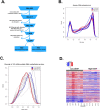Prenatal DEHP exposure predicts neurological disorders via transgenerational epigenetics
- PMID: 37149698
- PMCID: PMC10164151
- DOI: 10.1038/s41598-023-34661-3
Prenatal DEHP exposure predicts neurological disorders via transgenerational epigenetics
Abstract
Recent experimental and observational research has suggested that childhood allergic asthma and other conditions may be the result of prenatal exposure to environmental contaminants, such as di-(2-ethylhexyl) phthalate (DEHP). In a previous epidemiological study, we found that ancestral exposure (F0 generation) to endocrine disruptors or the common plasticizer DEHP promoted allergic airway inflammation via transgenerational transmission in mice from generation F1 to F4. In the current study, we employed a MethylationEPIC Beadchip microarray to examine global DNA methylation in the human placenta as a function of maternal exposure to DEHP during pregnancy. Interestingly, global DNA hypomethylation was observed in placental DNA following exposure to DEHP at high concentrations. Bioinformatic analysis confirmed that DNA methylation affected genes related to neurological disorders, such as autism and dementia. These results suggest that maternal exposure to DEHP may predispose offspring to neurological diseases. Given the small sample size in this study, the potential role of DNA methylation as a biomarker to assess the risk of these diseases deserves further investigation.
© 2023. The Author(s).
Conflict of interest statement
The authors declare no competing interests.
Figures





Similar articles
-
Maternal exposure to di(2-ethylhexyl)phthalate (DEHP) promotes the transgenerational inheritance of adult-onset reproductive dysfunctions through the female germline in mice.Toxicol Appl Pharmacol. 2017 May 1;322:113-121. doi: 10.1016/j.taap.2017.03.008. Epub 2017 Mar 9. Toxicol Appl Pharmacol. 2017. PMID: 28286118
-
Prenatal and ancestral exposure to di(2-ethylhexyl) phthalate alters gene expression and DNA methylation in mouse ovaries.Toxicol Appl Pharmacol. 2019 Sep 15;379:114629. doi: 10.1016/j.taap.2019.114629. Epub 2019 Jun 15. Toxicol Appl Pharmacol. 2019. PMID: 31211961 Free PMC article.
-
Multi and transgenerational epigenetic effects of di-(2-ethylhexyl) phthalate (DEHP) in liver.Toxicol Appl Pharmacol. 2020 Sep 1;402:115123. doi: 10.1016/j.taap.2020.115123. Epub 2020 Jul 3. Toxicol Appl Pharmacol. 2020. PMID: 32628958 Free PMC article.
-
Prenatal phthalate exposure: epigenetic changes leading to lifelong impact on steroid formation.Andrology. 2016 Jul;4(4):573-84. doi: 10.1111/andr.12175. Epub 2016 Apr 4. Andrology. 2016. PMID: 27044004 Review.
-
Fetal origin of endocrine dysfunction in the adult: the phthalate model.J Steroid Biochem Mol Biol. 2013 Sep;137:5-17. doi: 10.1016/j.jsbmb.2013.01.007. Epub 2013 Jan 17. J Steroid Biochem Mol Biol. 2013. PMID: 23333934 Review.
Cited by
-
Maternal symptoms of depression and anxiety as modifiers of the relationship between prenatal phthalate exposure and infant neurodevelopment in the Atlanta African American maternal-child cohort.Brain Behav Immun Health. 2024 Aug 10;40:100846. doi: 10.1016/j.bbih.2024.100846. eCollection 2024 Oct. Brain Behav Immun Health. 2024. PMID: 39224563 Free PMC article.
-
Impact of prenatal Di(2-ethylhexyl) phthalate exposure on pubertal development in female offspring rats: A focus on ERα-Mediated IGF-1/NKB crosstalk in the hypothalamus.Sci Rep. 2025 Jul 1;15(1):22255. doi: 10.1038/s41598-025-08253-2. Sci Rep. 2025. PMID: 40595203 Free PMC article.
-
Paternal DEHP Exposure Triggers Reproductive Toxicity in Offspring via Epigenetic Modification of H3K27me3.Toxics. 2025 Feb 27;13(3):172. doi: 10.3390/toxics13030172. Toxics. 2025. PMID: 40137499 Free PMC article.
-
Maternal di(2-ethylhexyl) phthalate exposure increases the risk of congenital heart disease in mice offspring.Pediatr Res. 2025 Mar 15. doi: 10.1038/s41390-025-03997-z. Online ahead of print. Pediatr Res. 2025. PMID: 40089607
-
Epigenetics and environmental health.Front Med. 2024 Aug;18(4):571-596. doi: 10.1007/s11684-023-1038-2. Epub 2024 May 28. Front Med. 2024. PMID: 38806988 Review.
References
Publication types
MeSH terms
Substances
LinkOut - more resources
Full Text Sources
Medical
Molecular Biology Databases

